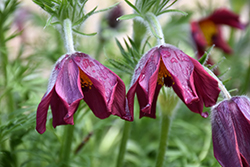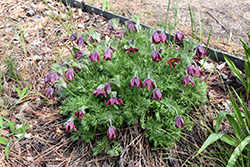It's all about ...
plants

Burgundy Pasqueflower
Pulsatilla vulgaris 'Burgundy'
Height: 8 inches
Spacing: 6 inches
Sunlight:
![]()
![]()
Hardiness Zone: 2a
Other Names: Prairie Crocus
Ornamental Features
Burgundy Pasqueflower has burgundy cup-shaped flowers with yellow eyes at the ends of the stems from early to mid spring, which are interesting on close inspection. The flowers are excellent for cutting. Its deeply cut ferny compound leaves remain green in colour throughout the season. The silver fruits are carried on plumes from early summer to early fall.
Landscape Attributes
Burgundy Pasqueflower is an herbaceous perennial with a mounded form. It brings an extremely fine and delicate texture to the garden composition and should be used to full effect.
This is a relatively low maintenance plant, and is best cleaned up in early spring before it resumes active growth for the season. Deer don't particularly care for this plant and will usually leave it alone in favor of tastier treats. It has no significant negative characteristics.
Burgundy Pasqueflower is recommended for the following landscape applications;
- Mass Planting
- Rock/Alpine Gardens
- General Garden Use
Planting & Growing
Burgundy Pasqueflower will grow to be about 8 inches tall at maturity, with a spread of 8 inches. When grown in masses or used as a bedding plant, individual plants should be spaced approximately 6 inches apart. It grows at a slow rate, and under ideal conditions can be expected to live for approximately 5 years. As an herbaceous perennial, this plant will usually die back to the crown each winter, and will regrow from the base each spring. Be careful not to disturb the crown in late winter when it may not be readily seen!
This plant does best in full sun to partial shade. It is very adaptable to both dry and moist growing conditions, but will not tolerate any standing water. It is considered to be drought-tolerant, and thus makes an ideal choice for a low-water garden or xeriscape application. It is not particular as to soil type or pH. It is somewhat tolerant of urban pollution. Consider covering it with a thick layer of mulch in winter to protect it in exposed locations or colder microclimates. This is a selected variety of a species not originally from North America.

